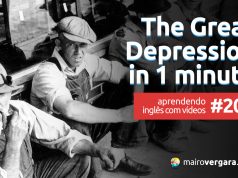Aprendendo inglês com vídeos é uma série de posts em que traremos para vocês vídeos acompanhados de transcrições e traduções, pois este é um material de altíssima qualidade para qualquer estudante de inglês. A grande maioria dos vídeos virão do YouTube, assim como forma de retribuir aos criadores dos vídeos incríveis que vamos usar, pedimos que você sempre dê o seu “Gostei” no vídeo (ao clicar para reproduzir o vídeo você verá a opção “gostei” no próprio vídeo)
Why Was A Wall Built Around West Berlin? (Transcrição)
1 – November 9th, 2015 marks 26 years since the fall of the Berlin Wall. It represented not only a physical barrier for the people of Germany, but an ideological divide that split the world in two. What many people don’t know about the Berlin Wall is that it did not run along the border between East and West Germany. Actually, it only encapsulated West Berlin, which was located deep in the heart of East Germany.
2 – So we wanted to know: why was the Berlin wall built in the first place, and how did West Berlin end up as a political island? Well, to put some of this in perspective, it’s important to note the state of Germany just after World War Two. The Germans lost the war, ceding the former Nazi power to the victorious Allies. The US, The UK, France, and The USSR carved up Germany.
3 – The easternmost portion, running along what was called the Oder Neisse line, was allocated to Poland to make up for land lost during the war. The rest of the country was split into four zones. The Soviet Union took over the zone to the east. The US, the UK, and France occupied their own zones in the Western half of the country. This just left Berlin. Technically, Berlin was in the Soviet Union’s territory.
4 – But since Berlin was the capital of Germany, as well as the former home of the Nazi regime, it held significant historical and political value. So to keep things fair, Berlin was carved up into four zones, mirroring the rest of Germany. Now, this arrangement worked … briefly, but soon, the USSR began planning to take over the rest of Berlin, then Germany, then Europe. At the time, the USSR was making a big push to expand socialism throughout its territories, including East Germany.
5 – So to accomplish this, the Soviet Union started restricting access to West Berlin, creating one of the first flashpoints of the Cold War, known as the Berlin Blockade. And things only got worse from there — the USSR began restricting emigration from their half of Germany. They built a massive wall, known as the “Inner-German Border” running down the middle of the country, with barbed wire, alarms, mines, and thousands of East German soldiers…
6 – By many accounts, life in the socialist, East Germany was pretty abysmal, particularly compared to the democratic and prospering West Germany. Thousands of East Germans defected, using a direct subway line between West Berlin and West Germany to bypass the closed border. To put an end to this, the Soviets erected the Berlin wall in 1961, running nearly 100 miles long. It completely surrounded West Berlin, which may seem counter-intuitive because you’d think they’d create a border to protect their own territory.
7 – But actually this wall was to keep their citizens from defecting to the West. The wall would stay in place for nearly three decades. Even though this wall was much smaller and less elaborate than the “Inner-German Border,” the Berlin wall came to symbolize the conflict between socialist and democratic nations. In 1989, the Berlin Wall came down, marking an end to the USSR’s stranglehold on East Germany.
8 – If you want to learn about what actually brought down the Berlin Wall, check out this video by Seeker Daily up at the top. And to see more of me, check out my videos on Fusion, including this one about how robots and avatars can be used to treat depression down at the bottom.
Por Que Foi Construída Um Muro Em Torno da Berlin Ocidental? (Tradução)
1 – 9 de novembro de 2015, fazem 26 anos desde a queda do Muro de Berlin. Ele representou não só uma barreira física para as pessoas da Alemanha, mas uma divisão ideológica que dividiu o mundo em dois. O que muitas pessoas não sabem sobre o Muro, é que ele não se extendia pela fronteira entre a Alemanha ocidental e oriental. Na verdade, somente emcapsulava a Berlin Ocidental, que era localizada profundamente no coração da Alemanha Oriental.
2 – Então, nós queríamos saber: por que foi construído um muro em primeiro lugar, e como a Berlin Ocidental acabou como uma ilha política? Bom, para colocar um pouco disso em perspectiva, é importante notar o estado da Alemanha logo depois da Segunda Guerra Mundial. Os alemães perderam a guerra, cedendo o antigo poder nazista para os aliados vitoriosos. Os EUA, O Reino Unido, França e a URSS dividiram a Alemanha.
3 – A porção mais oriental, correndo ao longo do que foi chamado de linha de Oder Neisse, foi atribuída a Polônia para compensar pela perda de território durante a guerra. O resto do país foi dividido em quatro zonas. A União Soviética tomou a zona do leste. Os EUA, o Reino Unido e a França, ocuparam suas próprias zonas na metade ocidental do país. Então só restou Berlin. Tecnicamente, Berlin estava no território da União Soviética.
4 – Mas como Berlin era a capital da Alemanha, como também o antigo lar do regime nazista, ela mantinha um significado histórico e político valioso. Então, para manter as coisas justas, Berlin foi dividida em quatro zonas, igualmente ao resto da Alemanha. Agora, esse acordo funcionou…por pouco tempo, mas logo depois, a URSS começou a planejar dominar o resto de Berlin, depois a Alemanha, depois a Europa. Na época, a URSS estava fazendo um grande esforço para expandir o socialismo pelos seus territórios, incluindo a Alemanha Oriental.
5 – Então, para alcançar isso, a União Soviética começou restringindo o acesso para Berlin Ocidental, criando um dos primeiros focos da guerra fria, conhecido como o Bloqueio de Berlin. E as coisas só ficaram piores a partir daí. A URSS começou a restringir a emigração da sua metade da Alemanha. Eles construíram um muro enorme, conhecido como “a fronteira interna alemã” correndo pelo meio do país, com arame farpado, alarmes, minas, e milhares de soldados da Alemanha Oriental.
6 – Por muitas razões, a vida na Alemanha Oriental socialista era bem terrível, principalmente comparada a Alemanha Ocidental, democrática e próspera. Milhares de alemães orientais desertaram, usando uma linha de metrô direta entre a Berlin Ocidental e a Berlin Oriental para atravessar a fronteira fechada. Para colocar um fim nisso, os soviéticos levantaram o Muro de Berlin em 1961, percorrendo aproximadamente 100 milhas de extensão. Ele completamente rodeava a Berlin Ocidental, o que pode parecer contraintuitivo, pois você poderia pensar que eles criariam uma fronteira para proteger seu próprio território.
7 – Mas na verdade, esse muro era para impedir seus cidadãos de desertarem para o Ocidente. O muro ficaria no lugar por aproximadamente três décadas. Embora esse muro fosse muito menor e menos elaborado que “a Fronteira Interna Alemã”, o Muro de Berlin veio para simbolizar o conflito entre nações socialistas e democráticas. Em 1989, o Muro de Berlin veio abaixo, marcando um fim para fortaleza da URSS na Alemanha Oriental.
8 – Se você quiser aprender sobre o que realmente derrubou o Muro de Berlin, dê uma olhada neste vídeo do Seeker Daily aqui em cima. E para ver mais de mim, veja os meus vídeos no Fusion, incluindo este sobre como os robôs e avatares podem ser usados para tratar a depressão, aqui em baixo.
Glossário de Estudos
Run along: Se extender por (uma determinada área, ou fronteira)
Make up for: Compensar por alguma coisa. Por tempo perdido, por exemplo, ou qualquer outra coisa.
Took over (Passado de Take Over): Dominar, tomar poder.
Carved up (Passado de Carve Up): No contexto do texto, significa dividir em partes.
Mirroring: Refletindo, espelhando, se igualando a algo.
Espero que vocês tenham gostado do vídeo de hoje e da transcrição/tradução! Como sempre, não deixem de visitar o vídeo no Youtube e dar o seu “gostei”, pois assim vocês estão ajudando o trabalho dos criadores desses vídeos incríveis! Link para o vídeo no YouTube: https://www.youtube.com/watch?v=W7YE-N448fg Abração e bons estudos a todos vocês!










